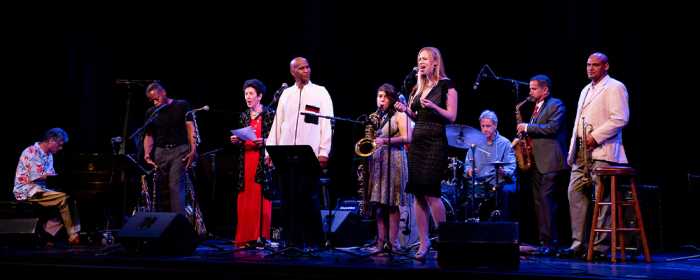Gov. Touts Energy, Environment Pgms.
Gov. Andrew M. Cuomo convened last week an Earth Week cabinet meeting to announce a series of innovative clean energy and environmental initiatives that will protect our state’s vast natural resources, increase energy conservation, and create jobs across New York State.
“New York State has a long and proud history of leading the nation in protecting the environment and promoting clean and affordable energy,” Cuomo said. “From the historic On- Bill Recovery Financing Program, to the NY-Sun Initiative, and Energy Highway project, New York State has been at the forefront of creating a more sustainable, cleaner future. The initiatives announced today will save businesses, homeowners, and taxpayers money and help ensure that our state remains a leader in clean energy production and environmental protection.”
The governor announced new investments in clean energy and environmental projects through the New York Power Authority (NYPA) and New York State Energy and Research Development Authority (NYSERDA), including $450 million to reduce energy consumption in state buildings by 20 percent and additional incentives for homeowners and businesses to install solar electric systems. The governor also stated that Intertek, a leading international provider of quality assurance testing and certification, will open the East Coast’s first Solar Testing Laboratory in Cortland and will launch a new Wind Turbine Blade Testing Lab at Clarkson University.
Cuomo also announced the launch of the Green Initiative at the New York State Pollution Prevention Institute at the Rochester Institute of Technology that will provide New York businesses with expertise and strategies for reducing the use of hazardous materials and improving sustainability.
In addition, the governor announced a series of honors awarded to state environmental programs and university students at New York campuses for green and sustainable initiatives.
The awardees included the State Environmental Facilities Corporation for its Green Infrastructure Grant Program, the Department of Environmental Conservation (DEC)’s Hudson River Estuary Program, and the New York State Pollution Prevention Institute, each of which was honored by the U.S. Environmental Protection Agency.
“The Governor has achieved precedent-setting environmental accomplishments through major legislative initiatives and substantial investments in protecting New York’s air, water and open spaces,” said DEC Commissioner Joe Martens. “New York’s innovative approaches to addressing environmental problems are receiving much-deserved national recognition by EPA. These programs illustrate how New York State integrates economic development with environmental protection.”
Rose Harvey, commissioner of the Office of Parks, Recreation and Historic Preservation, added, “New York’s parks are a crown jewel of our state, offering a place of tranquility, beauty and respite for millions of our residents each year. I commend Governor Cuomo for ensuring that our parks are granted the funding they need so important infrastructure projects can begin now and these treasures can be restored.”
Some of the details of the initiatives discussed at the Earth Week cabinet meeting include the following:
– NYPA will finance approximately $450 million in cost-effective energy efficiency projects over the next four years, with a goal to reduce energy consumption in state buildings by 20 percent. The efficiency upgrades include new lighting fixtures, heating, ventilating and airconditioning systems, electric motors, and automated energy management systems.
For many projects, no capital funding is needed upfront, as the energy savings will be used to pay back the loans.
The financing will be directed toward the largest and most inefficient buildings. Actual building data will be used to prioritize buildings for retrofit, and the most inefficient buildings and campuses will be retrofitted first. NYPA also intends to finance an additional $350 million over the next four years to provide energy efficiency financing and technical services to county and local governments and schools, helping to lower local government costs for taxpayers.
NYPA uses its low-cost financing for these projects and recovers its costs by sharing in the resulting electric-bill savings.
– The NY-Sun Initiative brings together and expands existing programs administered by NYSERDA, Long Island Power Authority (LIPA), and NYPA, to ensure a coordinated and well-funded solar energy expansion plan.
On Apr. 19, in time for Earth Day, the Public Service Commission approved doubling NYSERDA’s funding for customer-sited solar electric systems, known as solar photovoltaic (PV) energy systems, to $432 million over the next four years. The expanded solar program will increase financial incentives for large, commercial sized PV projects and expand incentive programs for small-to-medium residential and commercial systems.
– The DEC and the New York State Pollution Prevention Institute (NYSP2I) launched the Green Initiative to provide a sustainable road map for New York businesses.
The initiative was made possible through a $1.6 million allocation from the Environmental Protection Fund. Green Initiative programs will propel nascent green technologies and products to the next step in commercialization and provide expertise in developing a more sustainable manufacturing supply chain.
Last year, P2I helped New York businesses eliminate the use of 851,000 pounds of hazardous waste and materials, reduce non-hazardous material use by 10,000 pounds, and cut electrical energy use by 945,000 kwh and water use by 6.2 million gallons. These reductions saved participating companies $346,000 in 2011.
– Martens also presented the winners of the P2I “Greening Your Campus” competition, which was held yesterday in the Empire State Plaza Conference Center. Ten groups from four universities-Clarkson University, Rensselaer Polytechnic Institute, Rochester Institute of Technology, and the University of Buffalo-were challenged to propose a solution to a specific activity at their university that has a large environmental footprint.
The winning group from Clarkson University demonstrated up to $600,000 in potential energy savings through the installation of ultrasonic lighting sensors in university dormitories.

































